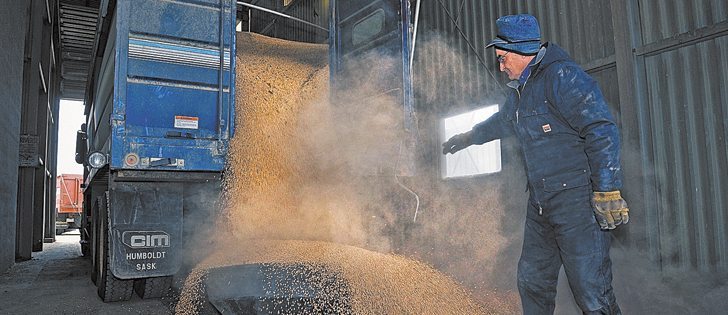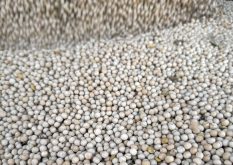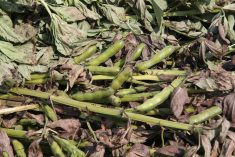Consumption up | Increased demand for domestic feed forecasted to drive down Canadian pea and lentil stocks
Statistics Canada’s Dec. 31 stocks report has transformed the market outlook for peas and lentils.
The report, released Feb. 5, revealed that Canada’s livestock sector consumed a lot more pulses from August to December than many forecasters had anticipated.
It is causing them to pull out their erasers and redo supply and demand charts for the two crops.
The report shows that 453,700 tonnes of peas were consumed domestically during the first five months of the crop year, up from 82,000 tonnes last year.
Chuck Penner, an analyst with LeftField Commodity Research, thinks feed use will slow in the second half of the year but the phenomenal first half numbers will cut pea ending stocks to 125,000 tonnes. Agriculture Canada’s pre-report estimate was 300,000 tonnes.
Read Also

Crop quality looks good this year across Prairies
Crop quality looks real good this year, with the exception of durum.
It would be the lowest pea ending stocks since 1993-94, providing additional price support for edible yellow peas, which are selling for $9 per bushel in some Alberta locations, said Penner in an article he wrote for Alberta Pulse Growers.
It’s the same story for lentils. Statistics Canada estimates the livestock sector consumed 340,000 tonnes through Dec. 31, up from 223,000 tonnes for the same period in 2011.
Stat Publishing analyst Brian Clancey said that could drive down lentil carryout stocks to 425,000 tonnes. Agriculture Canada’s pre-report estimate was for 700,000 tonnes of carryout.
Marlene Boersch, founding partner of Mercantile Consulting Venture Inc., was one analyst who had pencilled in a big domestic feed consumption number for both crops before the Dec. 31 stocks report.
“I’m not particularly surprised. I feel a little bit vindicated actually,” she said.
However, she’s pretty sure the report will confuse buyers because what looked to be an ample supply of pulses, particularly lentils, suddenly got a lot tighter.
Boersch said it’s easy to understand why growers sold into the feed market with feed pea prices of $8.25 to $8.50 per bu. in some locations, which wasn’t far off the price for edible peas.
“If you can deliver all the splits and brokens and don’t have to worry about any of those deductions, it often times pays to just dump it and go into the feed,” she said.
What happens to pea prices will largely depend on Indian demand. India’s agriculture department predicts 8.57 million tonnes of rabi (winter) chickpea production, up from 7.7 million tonnes last year.
If that is true, it could cap demand for Canadian yellow peas from Canada’s biggest customer.
Boersch is skeptical about the bullish chickpea estimate. She said there have been weather problems in India, and the government has a vested interest in inflating rabi season production to keep food price inflation in check because the kharif crop fell short of its pulse production target by 1.64 million tonnes.
“To me it looks a little bit like rigging,” she said.
She expects India to be back buying Canadian peas in March and April before the European Union comes out with contract offers in June and July.
Boersch believes Indian demand for lentils will be even stronger because its lentil and pigeon pea crops were smaller than expected.
“They will probably have to buy some more lentils. I see that (being) particularly supportive on the red lentil side.”
She expects the combination of strong Indian demand and shrinking Canadian stocks will boost red lentil prices one to two cents per pound by spring.
She’s not sure yet whether green lentil prices will follow. There is surging green lentil demand out of Colombia, Peru and other South American countries, but that is making up for poor early season demand for the crop.
Strong demand and tightening supply has her rethinking the lentil acreage forecast she provided in January at Pulse Days.
“In Saskatoon I said we might see a 15 percent drop in acres. I’m not so convinced on that anymore,” said Boersch.
Buyers will become nervous if acres are down 15 percent and the carryout is closer to 500,000 than 700,000 tonnes.
Another positive factor is that Australia’s huge chickpea harvest has been flying out the door.
Growers harvested 746,000 tonnes of the crop in 2012, up from 485,000 tonnes the previous year.
Clancey said 68 percent of the chickpeas that Australia was expected to ship in 2012-13 were sent by the end of December compared to 24 percent the previous year.
Australia has 267,000 tonnes left in the system to cover the remaining export program and next year’s seed supply, so competition from that exporter will calm down in the last half of 2012-13.


















